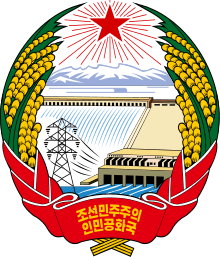Ten Principles for the Establishment of a Monolithic Ideological System
 |
| This article is part of a series on the politics and government of Democratic People's Republic of Korea |
|
|
|
Related topics |
Ten Principles for the Establishment of a Monolithic Ideological System (Chosŏn'gŭl: 당의 유일사상체계확립의 10대 원칙; also known as the "Ten Principles of the One-Ideology System") are a set of ten principles and 65 clauses which establishes standards for governance and guides the behaviors of the people of North Korea.[1]
Originally proposed by Kim Yong-ju, the younger brother of North Korean leader Kim Il-sung, in 1967 and made official by Kim Jong-il in 1974, the Monolithic Ideological System emerged in the context of internal policy debates within the Workers’ Party of Korea and the external challenges posed by the Sino-Soviet split. The Monolithic Ideological System was implemented by Kim Il-sung in order to squash internal dissent and cement his family's dominance over the North Korean political system.[2] The Ten Principles have come to supersede the national constitution or edicts by the Workers’ Party of Korea, and in practice serve as the supreme law of the country.[3][4][5]
The Ten Principles must be memorized by every citizen and they ensure absolute loyalty and obedience to Kim Il-sung, Kim Jong-il, and Kim Jong-un.[6][7] The Principles are integral to the political and daily lives of the people and are to be exercised through daily self-criticism sessions, in their work, school, etc. and forms the foundation of the country's pervasive cult of personality.[8][9]
The latest revisions to the Principles (done in 2013) remove every mention of "communism" (which had already been fully removed from their constitution by 2010) and requires loyalty to Kim Jong-un and his family.[3]
According to North Korean dictionaries, the Ten Principles are defined as follows: “The ideological system by which the whole party and people is firmly armed with the revolutionary ideology of the Suryeong (supreme leader) and united solidly around him, carrying out the revolutionary battle and construction battle under the sole leadership of the Suryeong.”[10]
Ten Principles
The original main ten principles are listed below:[11]
- We must give our all in the struggle to unify the entire society with the revolutionary ideology of the Great Leader Kim Il-sung.
- We must honor the Great Leader comrade Kim Il-sung with all our loyalty.
- We must make absolute the authority of the Great Leader comrade Kim Il-sung.
- We must make the Great Leader comrade Kim Il-sung's revolutionary ideology our faith and make his instructions our creed.
- We must adhere strictly to the principle of unconditional obedience in carrying out the Great Leader comrade Kim Il-sung's instructions.
- We must strengthen the entire party's ideology and willpower and revolutionary unity, centering on the Great Leader comrade Kim Il-sung.
- We must learn from the Great Leader comrade Kim Il-sung and adopt the communist look, revolutionary work methods and people-oriented work style.
- We must value the political life we were given by the Great Leader comrade Kim Il-sung, and loyally repay his great political trust and thoughtfulness with heightened political awareness and skill.
- We must establish strong organizational regulations so that the entire party, nation and military move as one under the one and only leadership of the Great Leader comrade Kim Il-sung.
- We must pass down the great achievement of the revolution by the Great Leader comrade Kim Il-sung from generation to generation, inheriting and completing it to the end.
See also
References
- ↑ Namgung Min (October 13, 2008). "Kim Jong Il's Ten Principles: Restricting the People". Daily NK. Retrieved January 20, 2014.
- ↑ Person, James. "The 1967 Purge of the Gapsan Faction and Establishment of the Monolithic Ideological System". NKIDP e-Dossier no. 15. Woodrow Wilson Center. Retrieved 5 March 2014.
- 1 2 "N. Korea revises leadership ideology to legitimize rule of Kim Jong-un". Yonhap News Agency. August 12, 2013. Retrieved January 20, 2014.
- ↑ Lim, Jae-Cheon (2008). Kim Jong-il's Leadership of North Korea. United Kingdom: Routledge. ISBN 9780203884720. Retrieved January 20, 2014.
- ↑ Green, Christopher. "Wrapped in a Fog: On the North Korean Constitution and the Ten Principles," Sino-NK, June 5, 2012. Retrieved January 3, 2016.
- ↑ Cha, John (2012). Exit Emperor Kim Jong-il. United States: Abbott Press. ISBN 978-1-4582-0216-1.
- ↑ Audrey Yoo (August 13, 2013). "North Korea rewrites rules to legitimise Kim family succession". South China Morning Post. Retrieved January 20, 2014.
- ↑ Staff (September 9, 2013). "What Are the 'Ten Principles'?". Daily NK. Retrieved January 20, 2014.
- ↑ Sung Hui Moon (December 17, 2013). "North Korea Steps Up Ideological Campaign Amid Tensions". Radio Free Asia. Retrieved January 20, 2014.
- ↑ Kang Mi Jin (September 13, 2013). "NK Adds Kim Jong Il to 'Ten Principles'". Daily NK. Retrieved January 20, 2014.
- ↑ Jeong-Ho Roh (2006). "Ten Principles for the Establishment of the One-Ideology System". Columbia Law School. Retrieved January 20, 2014.
External links
- Full text of the Ten Principles. PDF format, English (alternative link here)